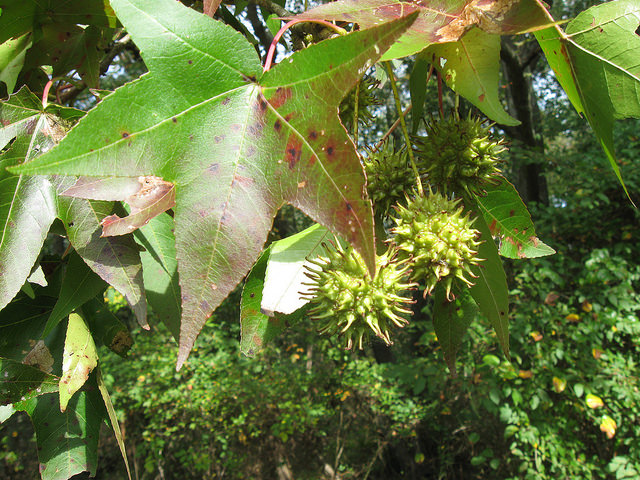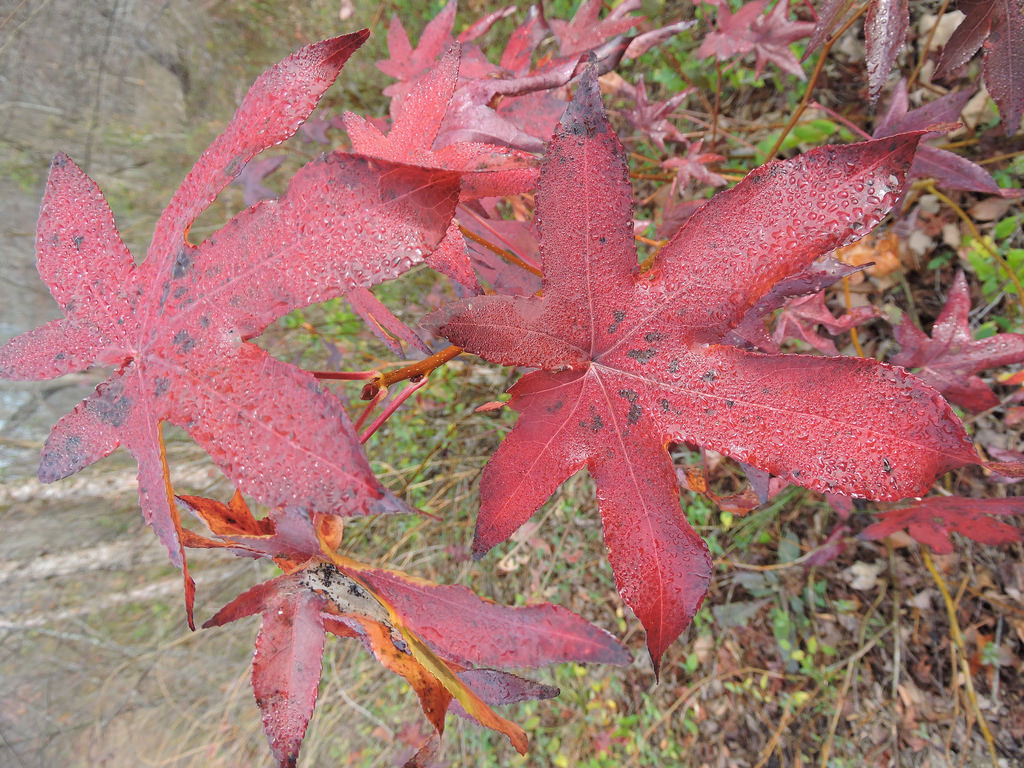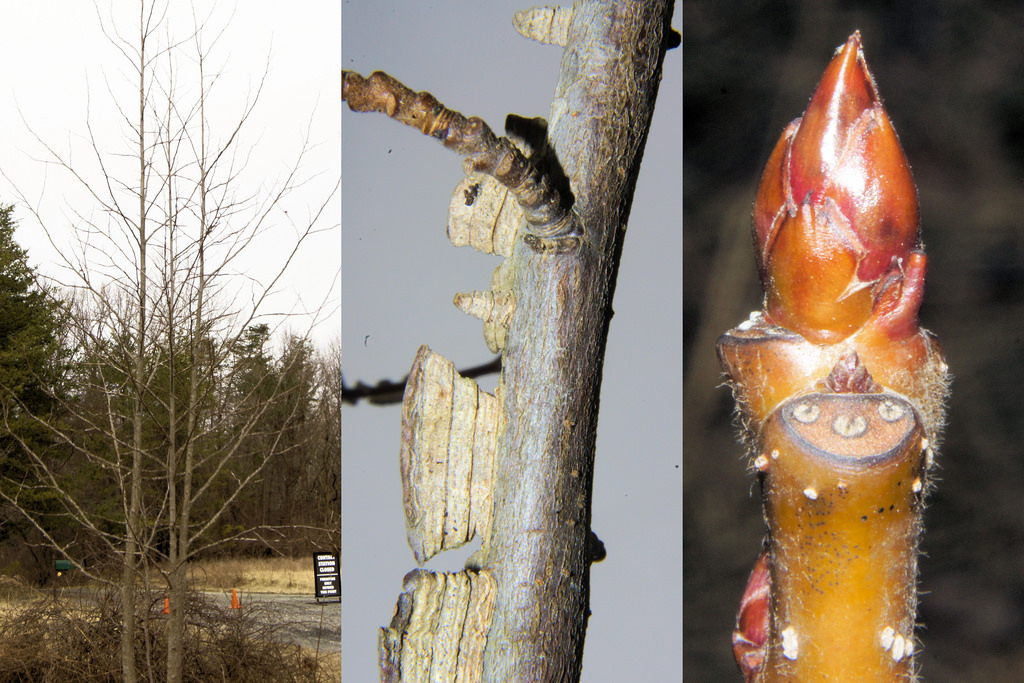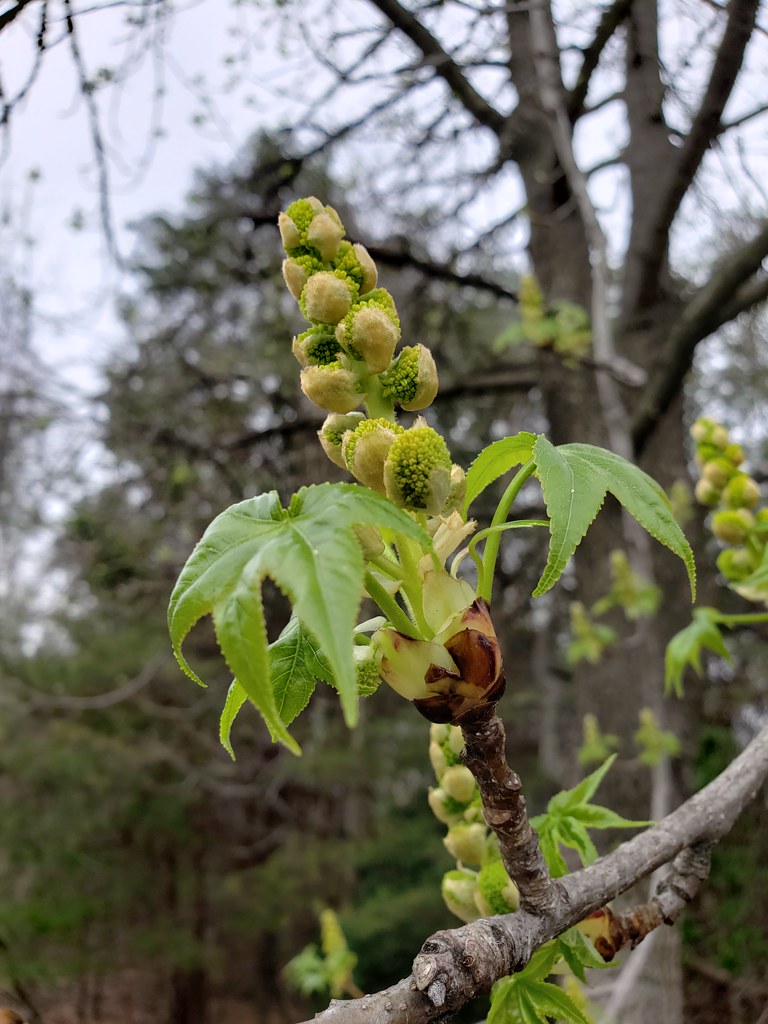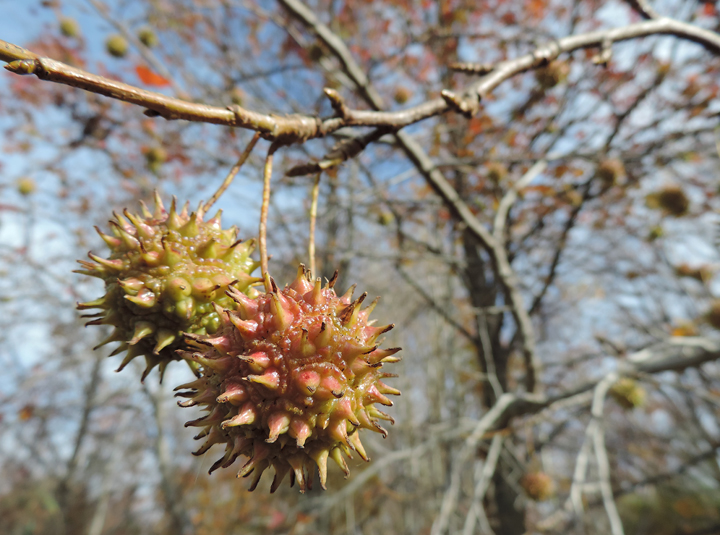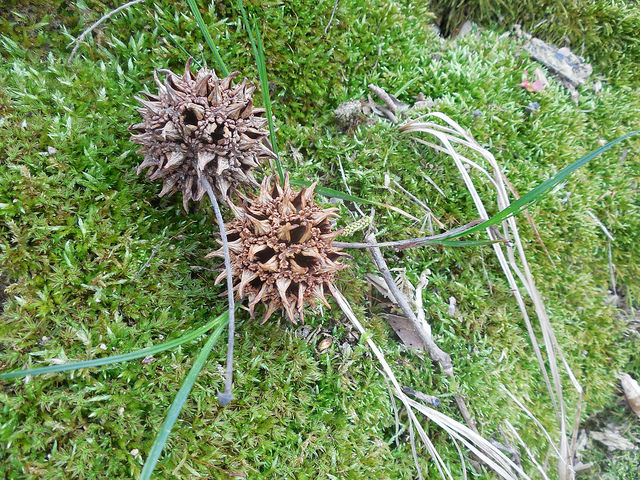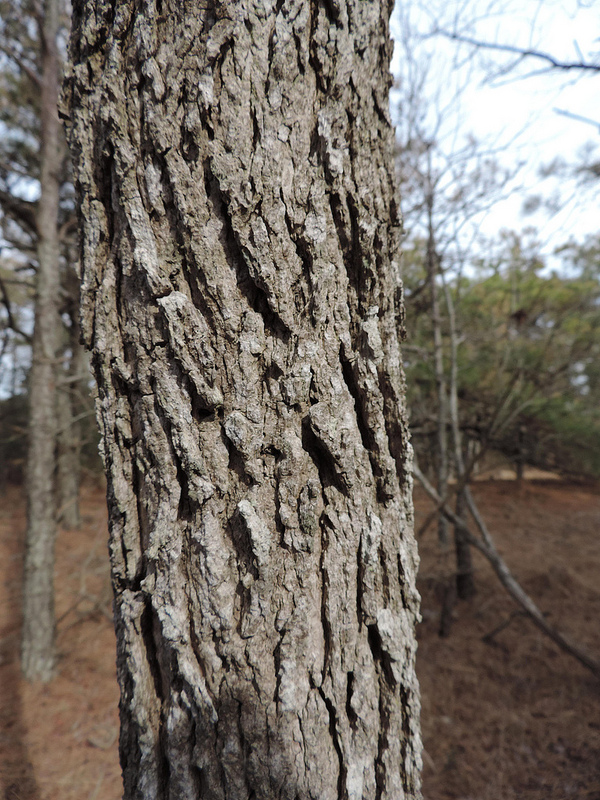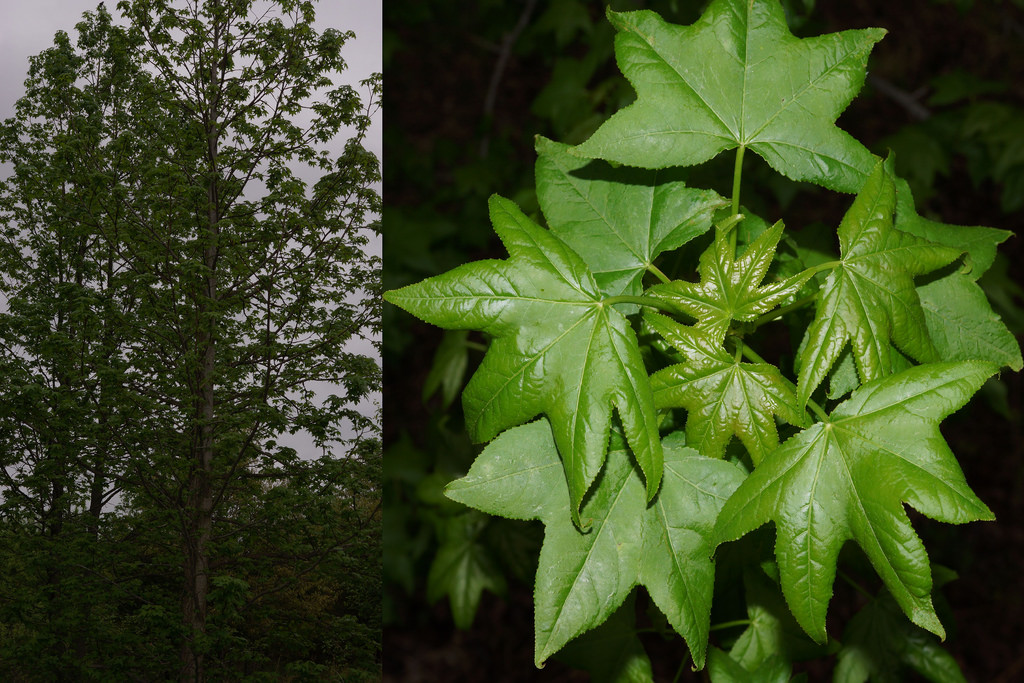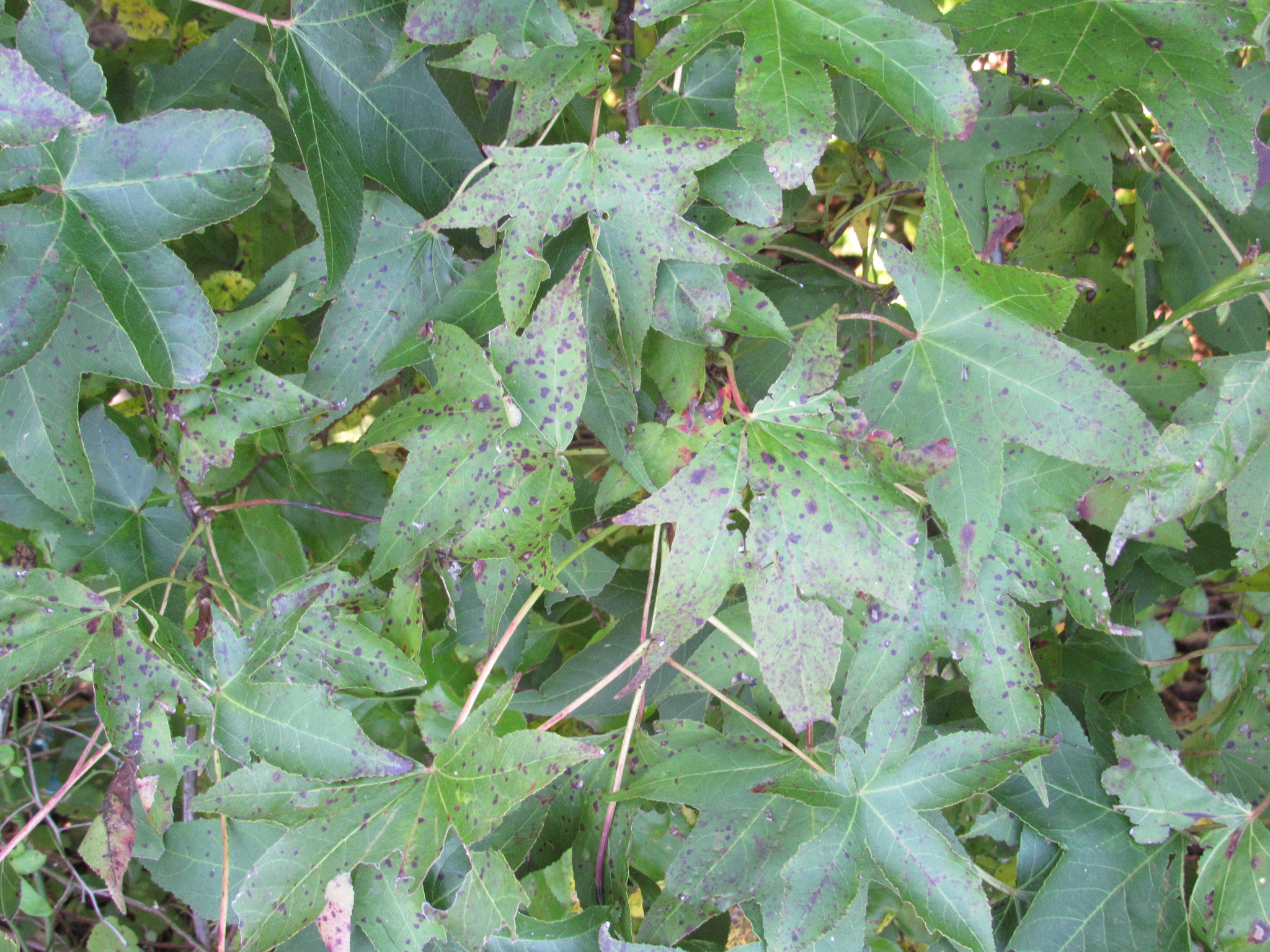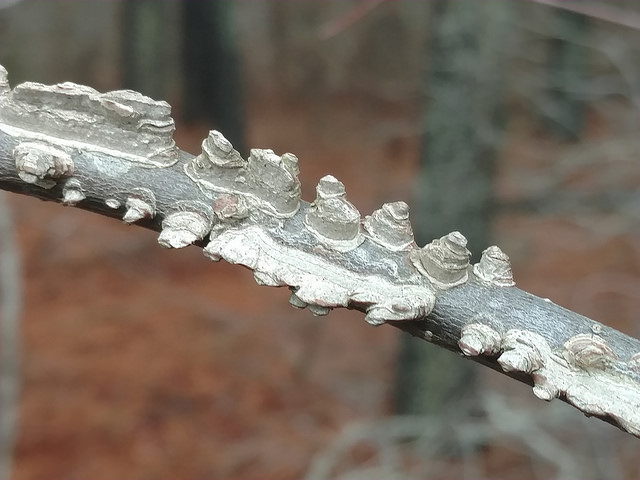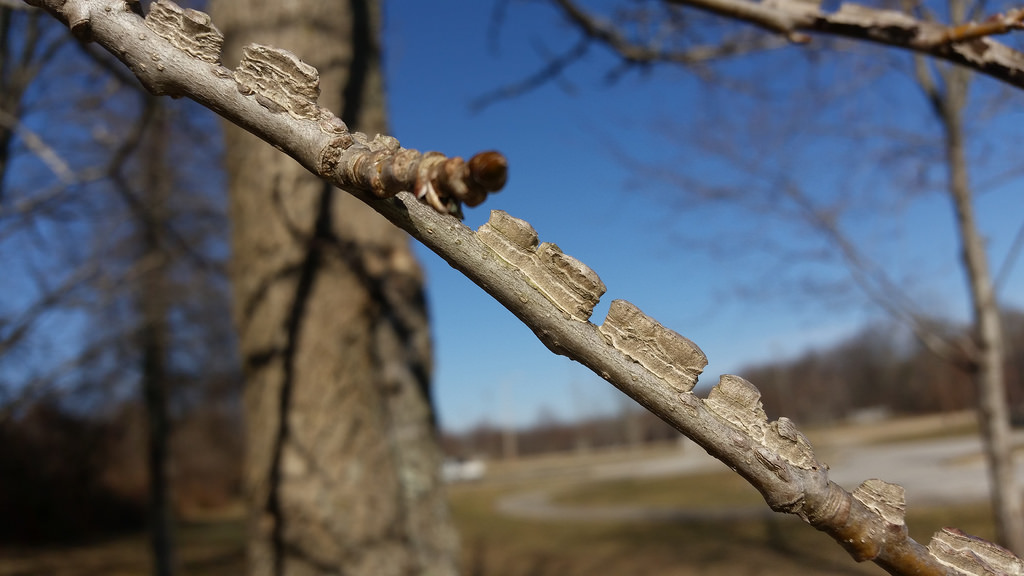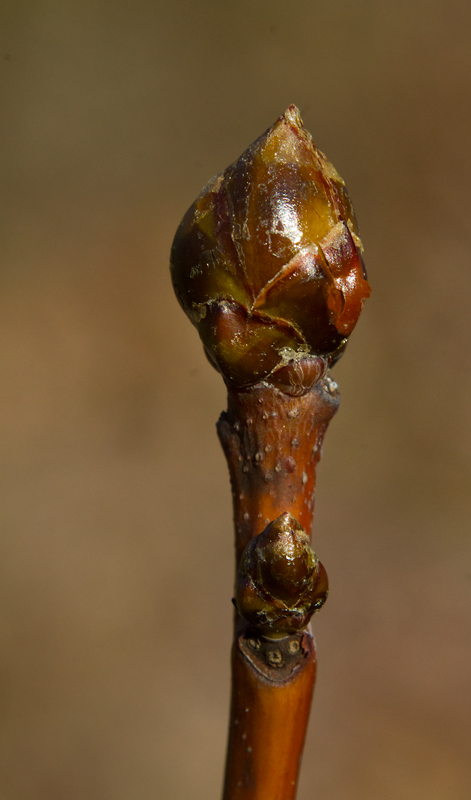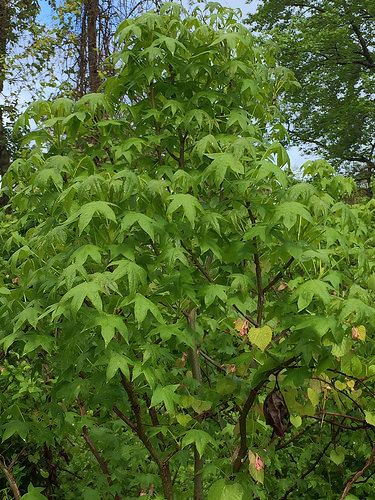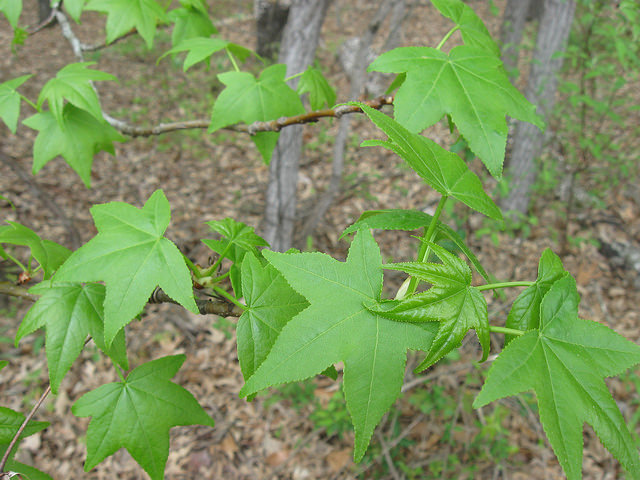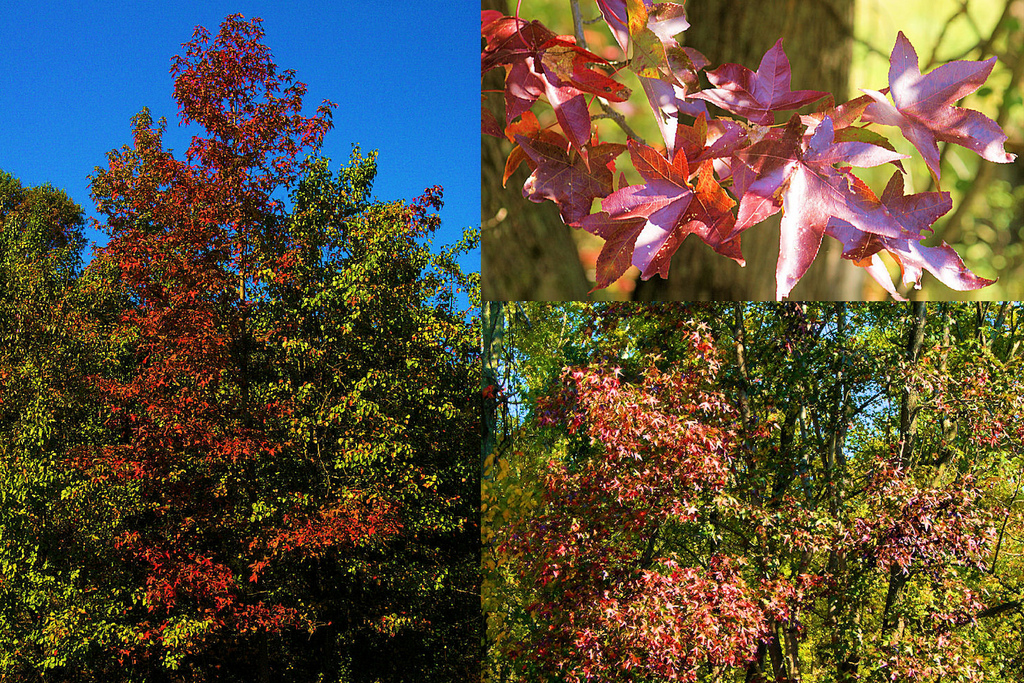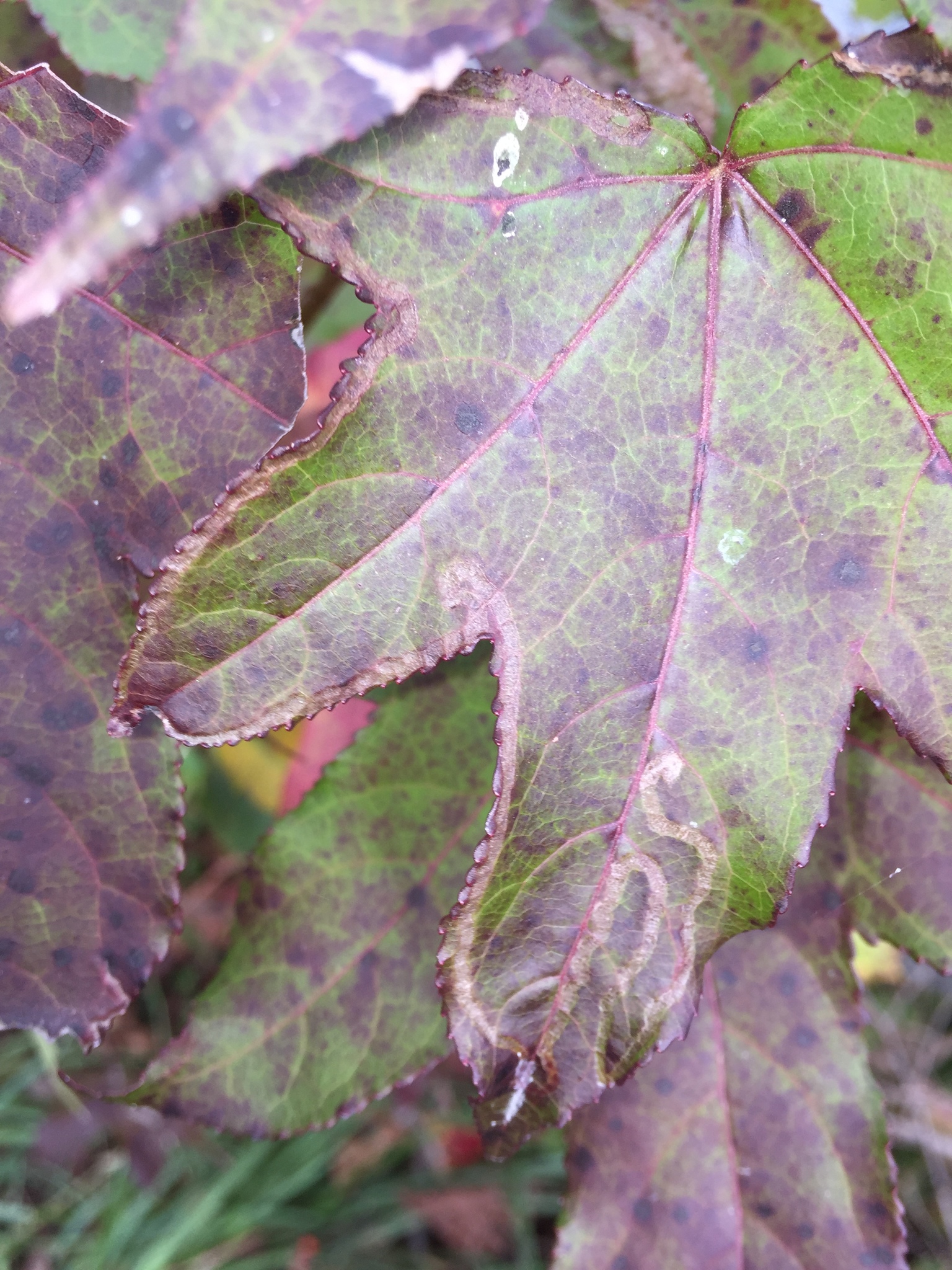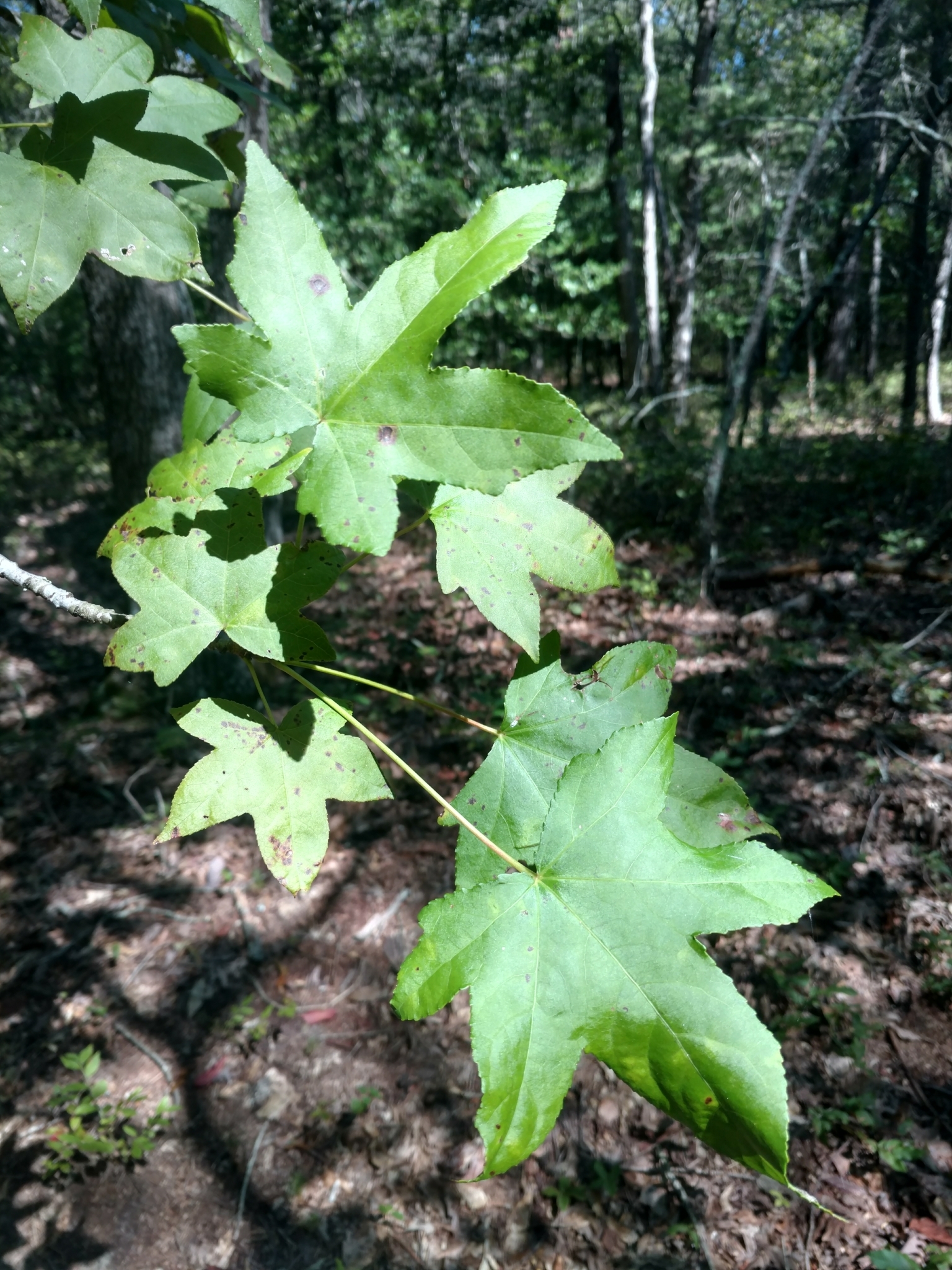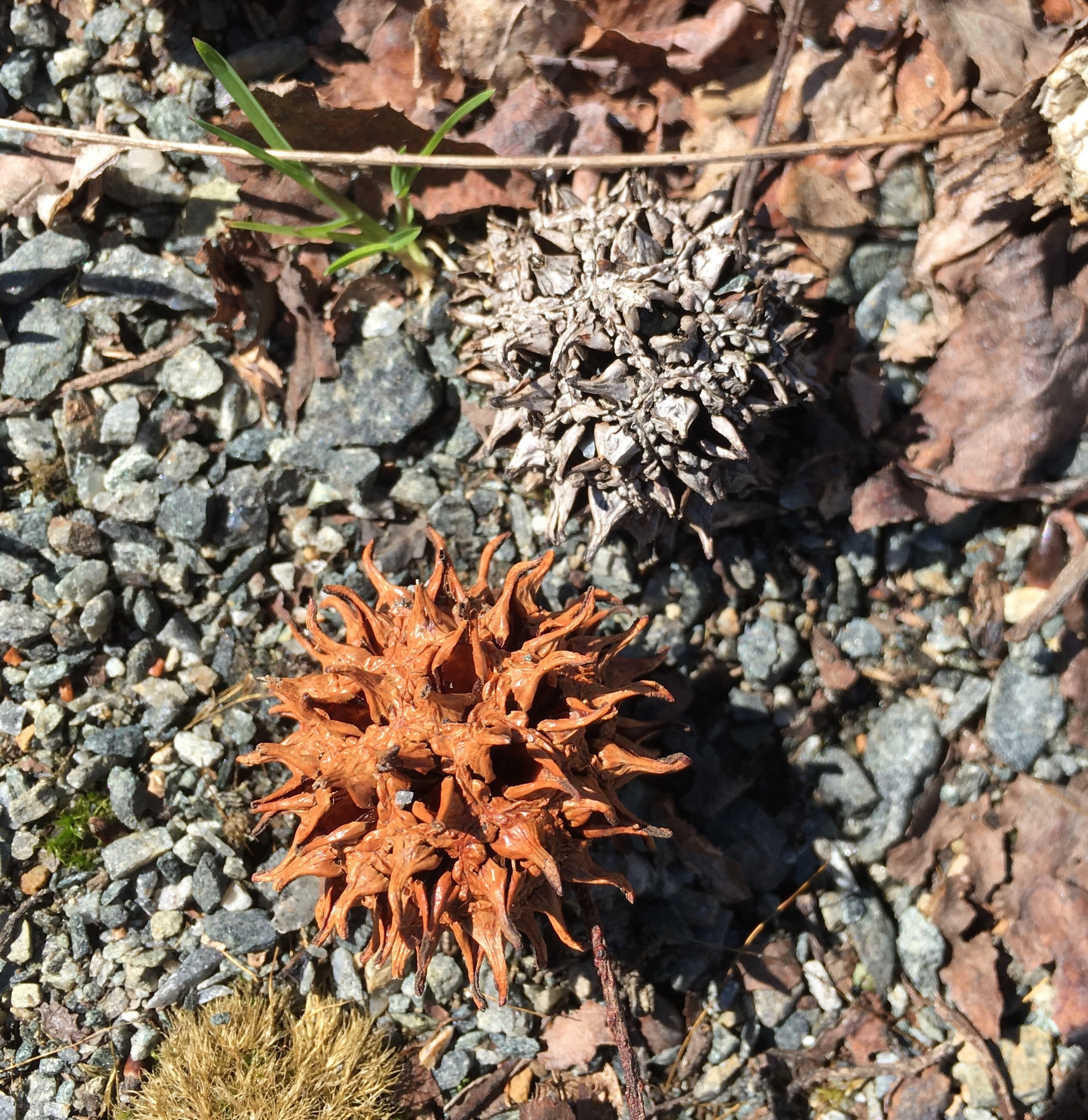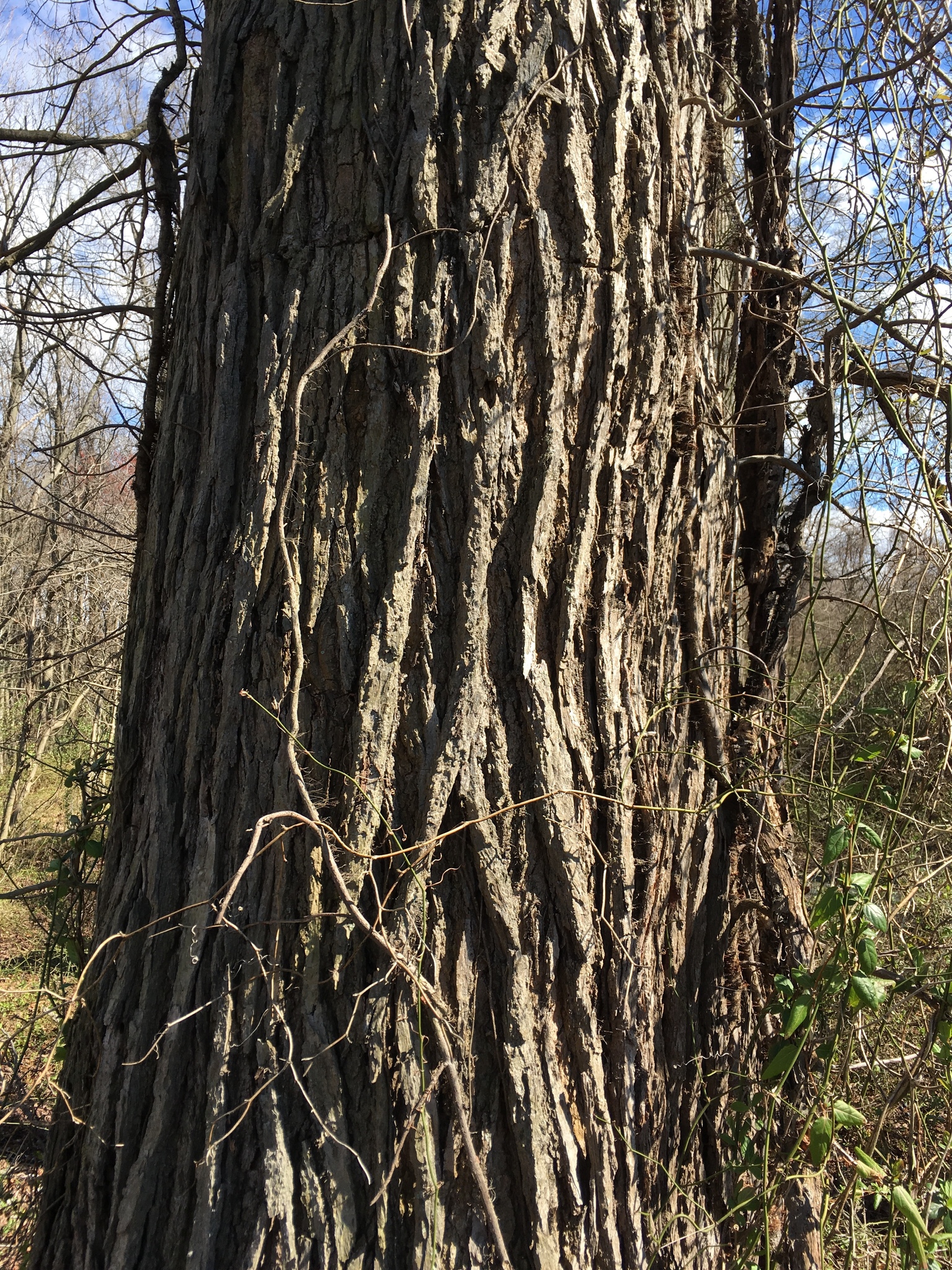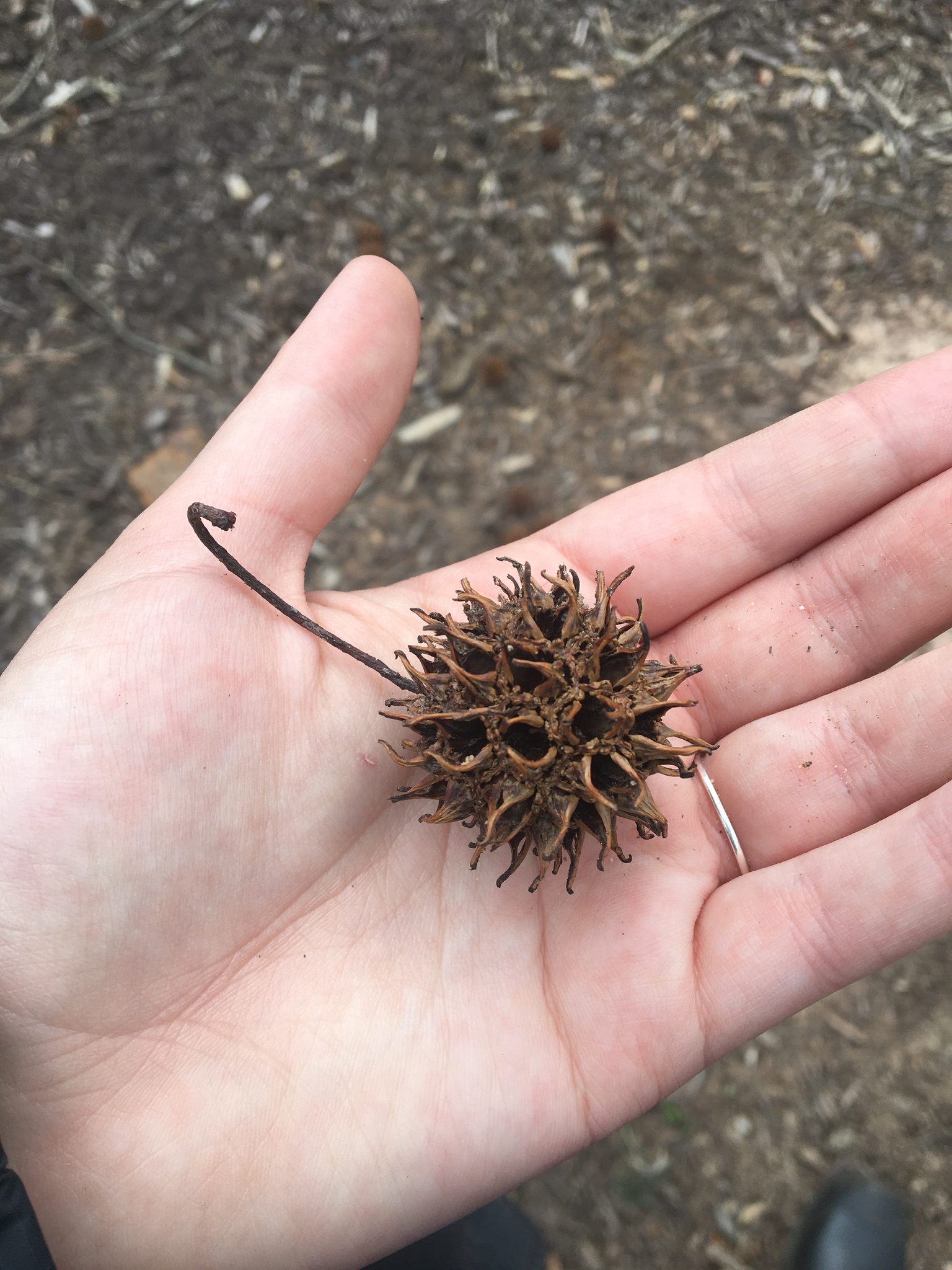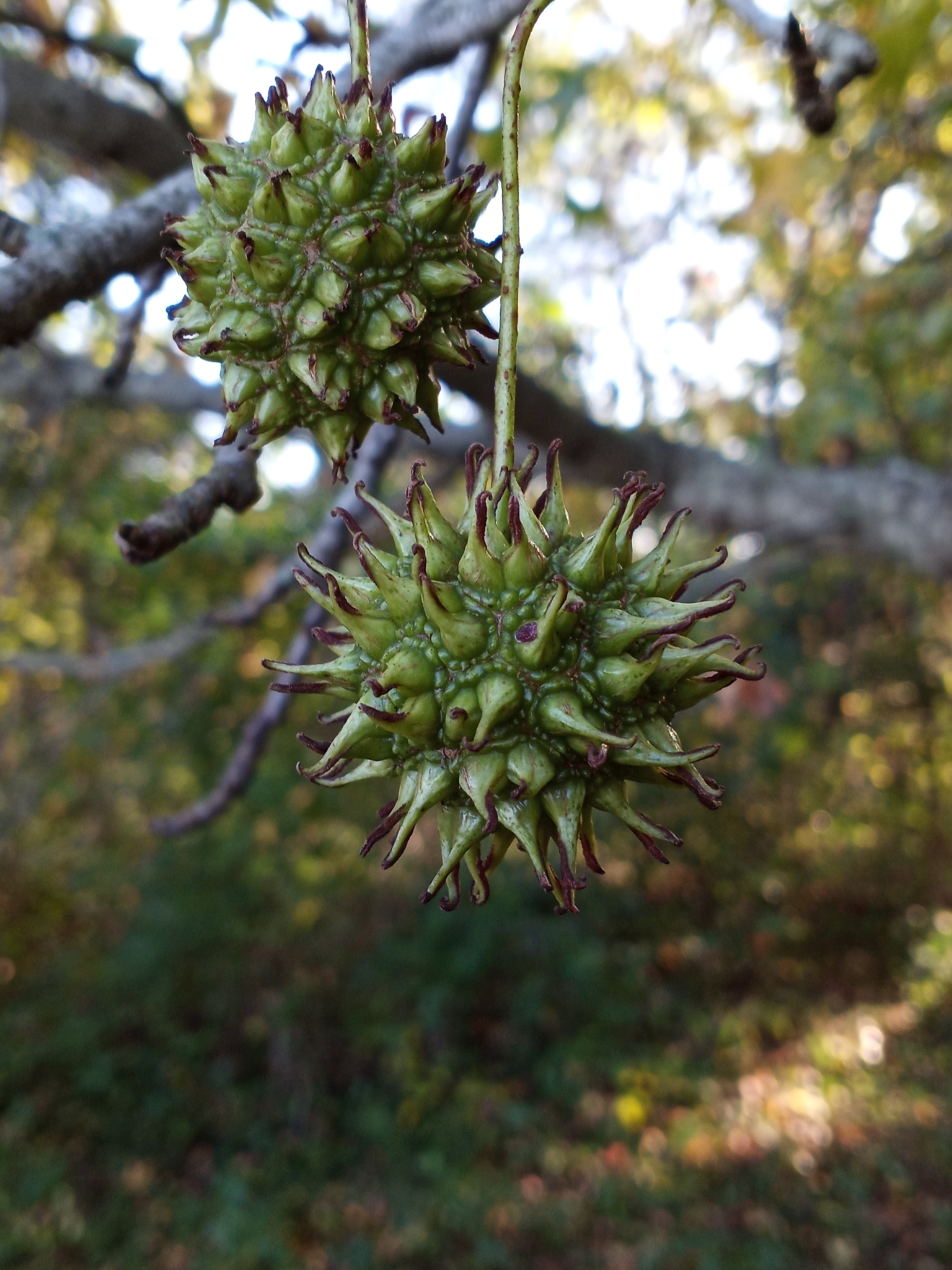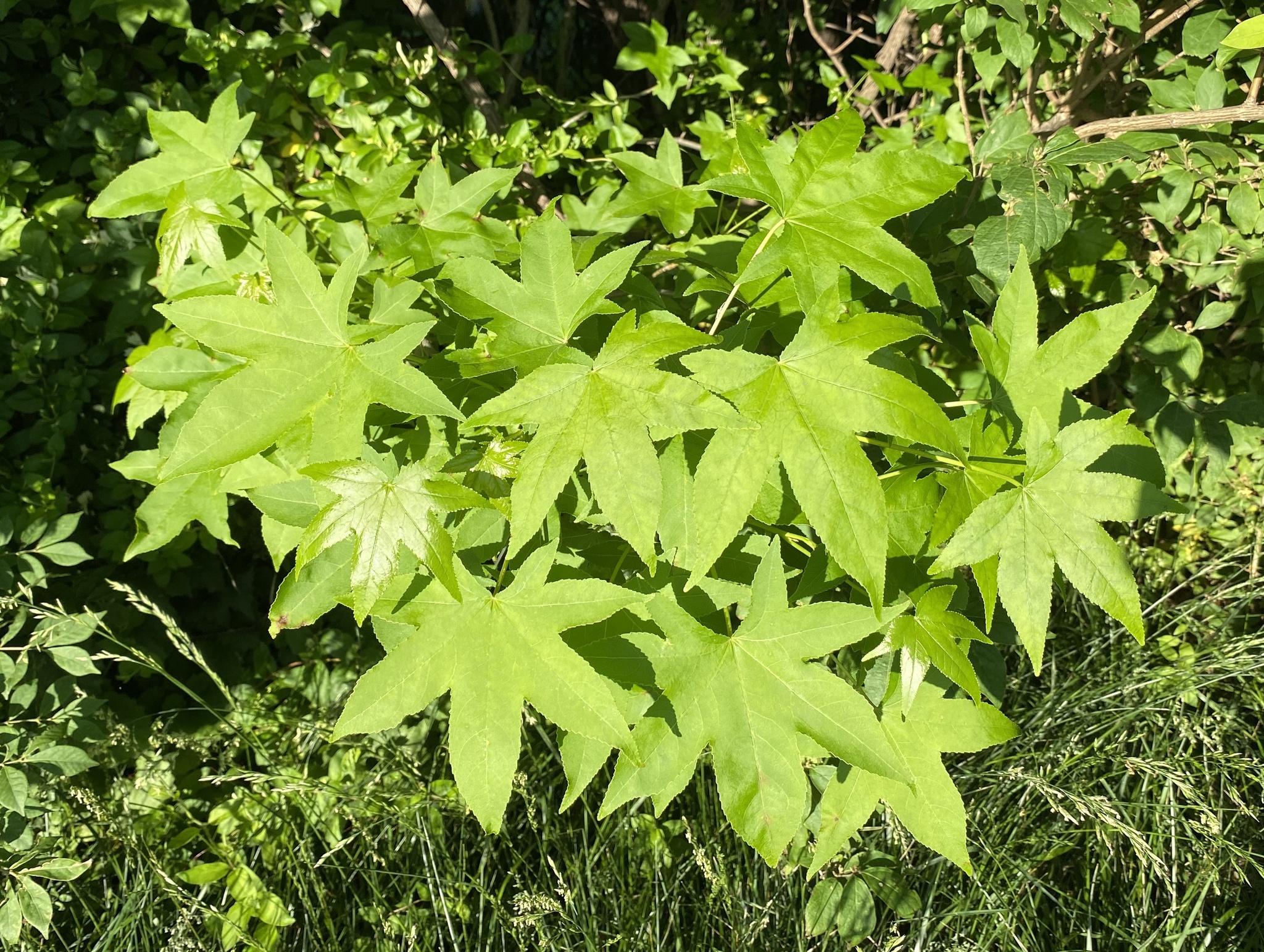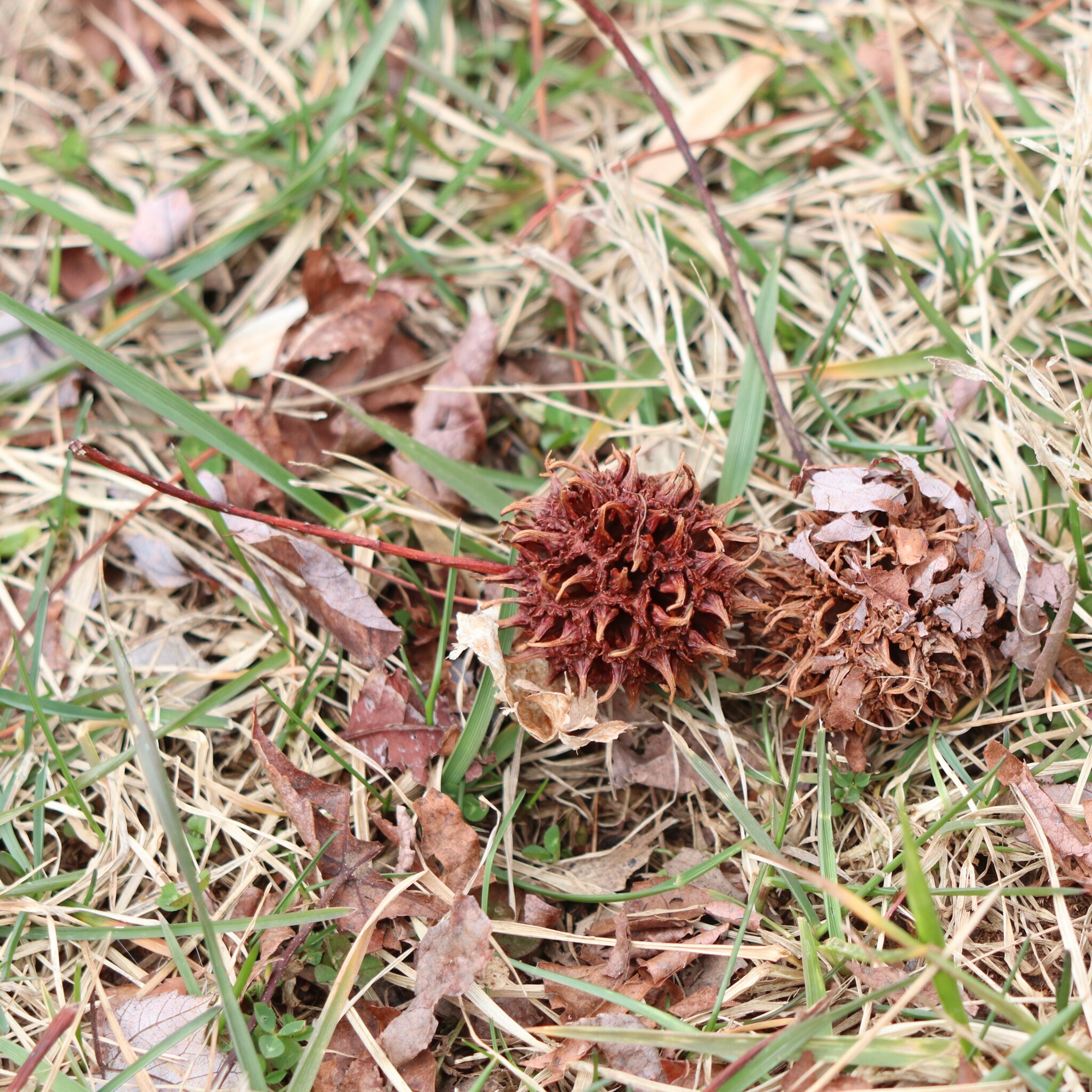Map Snapshot
























2,079 Records
Status
Sweet Gum is widely distributed, with a range from the Connecticut coast to the Guatemalan highlands. It grows mainly in bottomlands but also seeds into abandoned fields (Brown and Brown, 1972). Sweet Gum is very common on the Maryland Coastal Plain but uncommon in the Piedmont and west. It is fast growing and can become very large. It is often planted as an ornamental.
Description
Note distinctive leaf shape and seed pods. Branchlets commonly have corky ridges. Leaves often turn bright red in autumn. The seed pods (capsules) are filled mostly with abortive seeds that resemble sawdust (Fernald, 1950). Empty fruits often remain on the tree all winter.
Where To Find
A fine, ancient specimen of Sweet Gum can be seen in the old-age Shell-Marl Ravine Forest at Chapman Forest North (Chapman State Park), Charles County, Maryland. Sweet Gum is co-dominant in some of the stands there (R. Simmons, pers. comm.).
Relationships
Host plant to various moth species including Large Paectes Moth, Pygmy Paectes Moth, Imperial Moth, Luna Moth, Io Moth, Promethea Moth, Regal Moth, Cecropia Moth, Fall Webworm Moth, Banded Tussock Moth, Forest Tent Caterpillar Moth, Harris's Three-spotted Moth, and American Plum Borer (Database of the World's Lepidopteran Hostplants).
The moth Phyllocnistis liquidambarisella creates distinctive leaf mines on the leaves of Sweetgum.
The fungus Sweet Gum Fruit Fungus (Xylaria liquidambaris) can be found on dropped, decaying Sweet Gum fruit.
Seasonality Snapshot
Source: Wikipedia
| American sweetgum | |
|---|---|

| |
| Scientific classification | |
| Kingdom: | Plantae |
| Clade: | Tracheophytes |
| Clade: | Angiosperms |
| Clade: | Eudicots |
| Order: | Saxifragales |
| Family: | Altingiaceae |
| Genus: | Liquidambar |
| Species: | L. styraciflua
|
| Binomial name | |
| Liquidambar styraciflua | |

| |
| Natural range of L. styraciflua | |
| Synonyms[2] | |
| |
American sweetgum (Liquidambar styraciflua), also known as American storax,[3] hazel pine,[4] bilsted,[5] redgum,[3] satin-walnut,[3] star-leaved gum,[5] alligatorwood,[3] gumball tree,[6] or simply sweetgum,[3][7] is a deciduous tree in the genus Liquidambar native to warm temperate areas of eastern North America and tropical montane regions of Mexico and Central America. Sweetgum is one of the main valuable forest trees in the southeastern United States, and is a popular ornamental tree in temperate climates. It is recognizable by the combination of its five-pointed star-shaped leaves (similar to maple leaves) and its hard, spiked fruits. It is currently classified in the plant family Altingiaceae, but was formerly considered a member of the Hamamelidaceae.[8]
Names
[edit]This plant's genus name Liquidambar was first given by Linnaeus in 1753 from the Latin liquidus ('fluid') and the Arabic ambar ('amber'), in allusion to the fragrant terebinthine juice or gum which exudes from the tree. Its specific epithet styraciflua is an old generic name meaning 'flowing with storax' (a plant resin).[9] The name "storax" has long been confusingly applied to the aromatic gum or resin of this species, that of L. orientalis of Turkey, and to the resin better known as benzoin from various tropical trees in the genus Styrax.
The sweetgum has a Nahuatl name, Ocotzocuahuitl, which translates to 'tree that gives pine resin' from ocotl ('pine'), tzotl ('resin'), cuahuitl ('tree'), which refers to the use of the tree's resin.[10]
The common name "sweetgum" refers to the species' "sweetish gum",[11] contrasting with the blackgum (Nyssa sylvatica), only distantly related, with which the sweetgum overlaps broadly in range. The species is also known as the "redgum", for its reddish bark.[11]
History
[edit]The earliest known published record of Liquidambar styraciflua is in a work by Spanish naturalist Francisco Hernández published posthumously in 1615, in which he describes the species as a large tree producing a fragrant gum resembling liquid amber, whence the genus name Liquidambar. In John Ray's Historia Plantarum (1686) it is called Styrax liquida. However, the first mention of any use of the amber is described by Juan de Grijalva, the nephew of the governor of Cuba, in the year 1517. Juan de Grijalva tells of gift exchanges with the Mayas "who presented them with, among other things, hollow reeds of about a span long filled with dried herbs and sweet-smelling liquid amber which, when lighted in the way shown by the natives, diffused an agreeable odour."[12] The species was introduced into Europe in 1681 by John Banister, the missionary collector sent out by Bishop Compton, who planted it in the palace gardens at Fulham in London, England.
Fossil record
[edit]An ancestor of Liquidambar styraciflua is known from Tertiary-aged fossils in Alaska, Greenland, and the mid-continental plateau of North America, much further north than Liquidambar now grows. A similar plant is also found in Miocene deposits of the Tertiary of Europe.[13]
Description
[edit]Size
[edit]Liquidambar styraciflua is a medium-sized to large tree, growing anywhere from 15–20 m (50–70 ft) in cultivation and up to 45 m (150 ft) in the wild,[14] with a trunk up 60–90 cm (2–3 ft) in diameter, on average.[15] Trees may live to 400 years.[16] The tree is a symmetrical shape and crowns into an egg shape when the branches get too heavy after its first two years of cultivation.[9]
Bark and branches
[edit]Another distinctive feature of the tree is the peculiar appearance of its small branches and twigs. The bark attaches itself to these in plates edgewise instead of laterally, and a piece of the leafless branch with the aid of a little imagination readily takes on a reptilian form; indeed, the tree is sometimes called "alligatorwood".[13] The bark is a light brown tinged with red and sometimes gray with dark streaks and has a density of 590 kg/m3 (37 lb/cu ft).[15] It is deeply fissured with scaly ridges.[13] The branches carry layers of cork.[17] The branchlets are pithy, many-angled, winged, and at first covered with rusty hairs, finally becoming red brown, gray or dark brown.[13] As an ornamental tree, the species has a drawback—the branches may have ridges or "wings" that cause more surface area, increasing weight of snow and ice accumulation on the tree. However, the wood is heavy and hard with an interlocking grain,[9] but is difficult to season.[18]
-
Small branches with edgewise plates of bark
-
Deeply ridged bark
Leaves
[edit]The leaves usually have five (but sometimes three or seven) sharply pointed palmate lobes.[14] They are 8–13 cm (3–5 in) wide on average and have three distinct bundle scars.[19]
They are long and broad, with a 6–10 cm (2+1⁄4–4 in) petiole. The rich dark green, smooth, shiny, star-shaped leaves generally turn brilliant yellow, orange, red, and purple colors in the autumn.[9] This autumnal coloring has been characterized as not simply a flame, but a conflagration. Its reds and yellows compare to those of the maples (Acer), and in addition it has the dark purples and smoky browns of the ash (Fraxinus).[13] However, in the northern part of its range, and where planted in yet colder areas, the leaves are often killed by frost while still green. On the other hand, in the extreme southern or tropical parts of its range, some trees are evergreen or semi-evergreen, with negligible fall color. The leaves are 8–18 cm (3–7 in) broad with glandular serrate teeth. The base is truncate or slightly heart-shaped. They come out of the bud plicate, downy, pale green, when full grown are bright green, smooth, shining above, paler beneath.[13] They contain tannin and when bruised give a resinous fragrance.[18]
While the starry five-pointed leaves of Liquidambar resemble those of some maples (Acer), Liquidambar is easily distinguished from Acer by its glossy, leathery leaves that are positioned singly (alternate), not in pairs (opposite) on the stems. Luna and promethea moth caterpillars feed on the leaves.[20]
-
Summer foliage
-
Autumn foliage
Flowers
[edit]
The flowers typically appear in spring and persist into autumn/fall, sometimes persisting into winter. They are typically about 25–40 mm (1–1+1⁄2 in) in diameter and are covered with rusty hairs.[15] The flowers are unisexual[20] and greenish in color. Staminate flowers in terminal racemes 5–8 cm (2–3 in) long, the pistillate in a solitary head on a slender peduncle borne in the axil of an upper leaf. Staminate flowers destitute of calyx and corolla, but are surrounded by hairy bracts. Stamens indefinite; filaments short; anthers introrse. Pistillate flowers with a two-celled, two-beaked ovary, the carpels produced into a long, recurved, persistent style. The ovaries all more or less cohere and harden in fruit. There are many ovules but few mature.[13]
Fruit
[edit]The distinctive compound fruit is hard, dry, and globose, 25–40 mm (1–1+1⁄2 in) in diameter, composed of numerous (40–60) capsules.[15] Each capsule, containing one to two small seeds, has a pair of terminal spikes (for a total of 80–120 spikes). When the fruit opens and the seeds are released, each capsule is associated with a small hole (40–60 of these) in the compound fruit.
Fallen, opened fruits are often abundant beneath the trees; these have been popularly nicknamed "burr (or bir) balls",[16] "gum balls",[21] "space bugs", "sticker balls",[22] "spike balls", or "monkey balls".[23][24]
The fruit is a multicapsular spherical head and hangs on the branches during the winter. The woody capsules are mostly filled with abortive seeds resembling sawdust.[13] The seeds are about 6 mm (1⁄4 in) thick, winged, and wind-dispersed. Goldfinches, purple finches, squirrels, and chipmunks eat the seeds of the tree.[20] The seeds stratify within 30–90 days at 1–5 °C (33–41 °F) or soaked in water for 15–20 days.[19] The long-stemmed fruit balls of Liquidambar resemble those of the American sycamore or buttonwood (Platanus occidentalis), but are spiny and remain intact after their seeds are dispersed; the softer fruits of Platanus disintegrate upon seed dispersal. The long-persisting fallen spiked fruits can be unpleasant to walk on; sweet gum is banned in some places for this reason.[16] In abundance, they can leave a lawn lumpy. The winter buds are yellow brown, 6 mm (1⁄4 in) long, acute. The inner scales enlarge with the growing shoot, becoming 13 mm (1⁄2 in) long, green tipped with red.[13]
-
Green fruit
-
Leaf buds and fruit
-
American sweetgum tree ball (spiny seed pod)
-
Mature fruit and seed
-
Winged seeds
Distribution
[edit]Sweetgum is one of the most common hardwoods in the southeastern and Mid-Atlantic United States, where it occurs naturally in lowlands from southwestern Connecticut south to central Florida, through central Ohio and west to Illinois, southern Missouri, and eastern Texas, but not colder highland areas of Appalachia or the Midwestern states. The species also occurs in Mexico from southern Nuevo León south to Chiapas, as well as in Guatemala, El Salvador, Belize, Nicaragua and Honduras. In Mexico and Central America, it is a characteristic plant of cloud forests, growing at middle elevations in various mountainous areas where the climate is humid and more temperate.[9]
The US government distribution maps for this species are incorrect concerning the southern limit of distribution in Florida. This species occurs abundantly at Highlands Hammock State Park in Sebring, Highlands County, Florida, and even southwest of Lake Okeechobee.[25]
Uses
[edit]Wood
[edit]

Sweetgum (Liquidambar styraciflua) is one of the most important commercial hardwoods in the Southeastern United States.[26] Its wood is bright reddish brown (with the sapwood nearly white) and may have black grain in the heartwood; it is heavy, straight, satiny, and close-grained, but not strong. It takes a beautiful polish, but warps badly in drying. The wood has a specific gravity of 0.5910. It is too liable to decay for outdoor use.[13]
In the carpentry industry, the timber is referred to as satin walnut[14] and is one of the most important materials for plywood manufacturers. It is used for furniture, interior trim, railroad ties, cigar boxes, crates, flooring, barrels, woodenware, and wood pulp.[27] It is also used for veneer for plywood. The wood is very compact and fine-grained, the heartwood being reddish, and, when cut into planks, marked transversely with blackish belts. Sweetgum is used principally for lumber, veneer, plywood, slack cooperage, fuel, and pulpwood. The lumber is made into boxes and crates, furniture, cabinets for radios, televisions, and phonographs, interior trim, and millwork. The veneer and plywood, (typically backed with some other kind of wood which shrinks and warps less) are used for boxes, pallets, crates, baskets, and interior woodwork. It was formerly used in the interior finish of railroad sleeping cars. Being readily dyed black, it is sometimes substituted for ebony for such uses as inexpensive picture frames.[13][28] The wood is also used to make chopsticks for the East Asian market, as it has a naturally light color with appeal to certain segments of the Asian market.[29]
Resin
[edit]The tree's gum resin, for which the tree is named, exudes from the bark of the tree when wounded.[20] It has many names, including liquid amber or copalm balsam. It is a kind of native balsam, or resin, resembling turpentine. It may be clear, reddish, or yellow, with a pleasant smell like ambergris. As the resin ages, it solidifies, the form in which it was historically exported in barrels. The resin is produced by stripping, boiling, and pressing the tree's bark.[16] The gum was used both medicinally and to make chewing gum.[30]
Shikimic acid
[edit]L. styraciflua seeds may be a renewable source of shikimic acid.[31]
Medicinal
[edit]Traditionally, sweet gum has been used in Chinese medicine to treat issues such as diarrhea, coughs, and skin sores.[32]
Cultivation
[edit]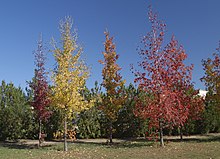

Liquidambar styraciflua is a popular ornamental and forestal tree, cultivated for its distinctive foliage and intense autumn colors. It is commonly grown throughout its native North American range as well as many other temperate parts of the world, including moderately high elevations in the tropics. It is highly regarded in Bogota, Colombia.[33] The species grows best in moist, acidic loam or clay soil, and tolerates poor drainage. It typically grows with other coastal plain species such as willow oak and sweetbay magnolia.[20] Its salt tolerance is moderate. Chlorosis can develop on alkaline soil, especially where organic matter is low. Also, the American sweetgum tree does not grow well in shady areas.[15] Grown as an ornamental tree in Australia, Liquidambar styraciflua has a distribution on mainland Australia from southwestern Western Australia, southern South Australia, New South Wales, Victoria, and all the way up to the Atherton Tablelands in far North Queensland.[34]
During the late 1970s and throughout the 1980s, Sweetgums were a popular landscaping and street tree. Three varieties, Palo Alto, Festival, and Burgundy, introduced in the late 1950s by the Saratoga Horticultural Foundation in Palo Alto, California became popular in the urban landscapes of California because of their pleasing appearance, striking fall colors, and ability to grow quickly and thrive; however, as the trees matured, the damage caused by surface roots and the increased production of seed balls led to the tree being considered a nuisance and a liability. Thousands of trees would be removed and repairs had to be conducted on nearby structures damaged by roots. The Western Arborist published a study that concluded that Sweetgums accounted for the greatest number of trees causing damage; in the city of Alameda alone it was found that 69% of Liquidambars planted in the city were either damaging or beginning to damage nearby structures. It is now recommended that the trees be planted at least 15 to 20 feet from structures and that they should not be used as street trees.[35]
Among the many cultivars of Liquidambar styraciflua are (those marked agm have gained the Royal Horticultural Society's Award of Garden Merit):[36]
- 'Burgundy' – dark red to purple fall colors may persist through winter
- 'Clydesform' – columnar or narrowly pyramidal; slow growth to 9 meters; yellow-orange fall colors; also sold as 'Emerald Sentinel'
- 'Festival' – columnar; pale green summer leaves; bright fall hues of yellow, pink and red; less hardy than most
- 'Firehouse' - pyramidal; bright red fall color; defoliates early; little to no seed production
- 'Goduzam' – variegated; pink to red-purple in autumn; also called 'Gold Dust'
- 'Grazam' – pyramidal, with glossy leaves. Orange, red and purple fall colors
- 'Gumball' – dwarf shrubby cultivar seldom more than 2 m (6+1⁄2 ft) tall, with purple-red fall color
- 'Lane Roberts' (agm)[37]
- 'Moraine' – upright, rounded form, fast growth, red fall color, hardy to −30 °C
- 'Palo Alto' – various shades of red in fall; best in California
- 'Parasol' – develops rounded crown; mature height 10 meters; deep red fall color
- 'Penwood' (agm)[38]
- 'Rotundiloba' – sterile cultivar with rounded lobes on leaves, originally discovered in North Carolina in the 1930s
- 'Slender Silhouette' – very narrow columnar form
- 'Worplesdon' (agm)[39] – cutleaf cultivar with orange, red and purple fall colors

The organizers of the September 11th Memorial in New York donated a grove of sweetgum trees to the Flight 93 Memorial in Shanksville, Pennsylvania.[40]
Infection on Liquidambar styraciflua
[edit]The imperfect fungus Dicarpella dryina Sutton is a leaf parasite reported to occur on a wide range of host plants, including species of sweetgum (Liquidambar styraciflua L.). Limber and Cash reported that leaf spots produced by this pathogen on several different genera of forest trees were 2–5 mm diameter with regular margins. During the summer of 1994 in the Nacogdoches County area of Texas, a prominent leaf spot on sweetgum was widespread. Infected leaves had numerous necrotic lesions, each surrounded by a reddish halo. The lesions tended to merge resulting in large areas of dead tissue. Infection and fungal development of D. dryina were investigated on leaves of sweetgum using a combination of microscopic techniques. D. dryina infection on sweetgum has been associated with the disease red leaf spot. Results of this investigation indicate that D. dryina can penetrate leaf tissue directly, thus having the ability to initiate infection on both upper and lower leaf surfaces. In other regions of the U.S., sweetgum populations may not be as susceptible to local populations of this fungus.
Environmental stress factors may also be involved, as reports have indicated that herbicide application and chlorosis caused by iron deficiency may increase susceptibility of D. dryina. Tannins (a type of biomolecule found in trees to protect it from fire, insects, and bacteria) have been reported to occur in healthy tissue of a variety of plants including sweetgum. They may prevent pathogen invasion by inhibiting fungal enzyme activity. Although cells of healthy sweetgum tissue appear rich in tannins, these materials apparently were not effective in preventing fungal colonization by D. dryina.[41]
References
[edit]- ^ Beech, E.; Crowley, D.; Rivers, M.C.; Wilson, B. (2018). "Liquidambar styraciflua". IUCN Red List of Threatened Species. 2018: e.T33966A67700725. doi:10.2305/IUCN.UK.2018-1.RLTS.T33966A67700725.en. Retrieved 12 November 2021.
- ^ Liquidambar styraciflua L. Plants of the World Online, Kew Science. Accessed 9 February 2023.
- ^ a b c d e "Liquidambar styraciflua". Germplasm Resources Information Network. Agricultural Research Service, United States Department of Agriculture. Retrieved 11 December 2017.
- ^ "hazel pine Liquidambar styraciflua American sweetgum – Dizionario inglese-italiano WordReference". Wordreference.com. Retrieved 30 December 2017.
- ^ a b Small, J.K. (1933). Manual of the southeastern flora: being descriptions of the seed plants growing naturally in Florida, Alabama, Mississippi, eastern Louisiana, Tennessee, North Carolina, South Carolina and Georgia. Chapel Hill, N.C.: University of North Carolina Press. ISBN 0-02-852410-1.
- ^ Nolan, Jessica; Expert, Gardening (14 April 2021). "Sweetgum Trees (Gumball Tree): Types, Leaves - Identification (Pictures)". Leafy Place. Retrieved 9 July 2024.
- ^ RHS A-Z encyclopedia of garden plants. United Kingdom: Dorling Kindersley. 2008. p. 1136. ISBN 978-1405332965.
- ^ Cafferty, Steve. "Taxonomy". Encyclopedia of Life. Natural History Museum. Retrieved 26 September 2012.
- ^ a b c d e Grimm, William (1967). Familiar Trees of America. New York: Harper & Row. pp. 153–154.
- ^ Austin, Daniel F. (29 November 2004). Florida Ethnobotany. CRC Press. p. 407. ISBN 9780203491881.
- ^ a b Werthner, William B. (1935). Some American Trees: An intimate study of native Ohio trees. New York: The Macmillan Company. pp. xviii + 398 pp.
- ^ Corti, Count (1931). A History of Smoking. london: George G. Harrap & Co. Ltd. p. 44.
- ^ a b c d e f g h i j k Keeler, Harriet L. (1900). Our Native Trees and How to Identify Them. New York: Charles Scribner's Sons. pp. 160–164.
- ^ a b c Cafferty, Steve (2005). Firefly Encyclopedia of Trees. Buffalo, NY: Firefly. pp. 116–117.
- ^ a b c d e Illick, Joseph (1928). Pennsylvania Trees. Harrisburg, Pennsylvania: Pennsylvania Department of Forests and Waters. pp. 168–169.
- ^ a b c d "Liquidambar styraciflua: American sweet gum". Cal Poly Plant Conservatory. Archived from the original on 28 March 2012. Retrieved 26 July 2011.
- ^ "Liquidambar styraciflua", The Macquarie Dictionary of Trees and Shrubs, South Yarra: The Macquarie Library Pty Ltd.
- ^ a b New-Hall, Charles (1890). The Trees of North-eastern America. New York: Knickerbocker. pp. 130–131.
- ^ a b Leopold, Donald (1998). Trees of the Central Hardwood Forests of North America: An Identification and Cultivation Guide. Portland, Oregon: Timber. pp. 235–237.
- ^ a b c d e Rhoads, Ann (2005). Trees of Pennsylvania: A Complete Reference Guide. Philadelphia: University of Pennsylvania.
- ^ Missouri Botanical Garden: Liquidambar styraciflua
- ^ Jordan, Ramon. "US National Arboretum Picture of the Week Answer -". Usna.usda.gov. Retrieved 30 December 2017.
- ^ Smith, Paul (February 2018). The Book of Seeds : A Lifesize Guide to Six Hundred Species from Around the World. Ivy Press. p. 253. ISBN 9781782406815. Retrieved 22 February 2023.
- ^ "Liquidambar styraciflua". University of Delaware Botanic Gardens. Retrieved 22 February 2023.
- ^ "Liquidambar styraciflua – Species Details". Atlas of Florida Plants. University of South Florida. Retrieved 30 December 2017.
- ^ Kormanik 1990.
- ^ "Sweetgum", McGraw-Hill Concise Encyclopedia of Science and Technology, New York: McGraw-Hill
- ^ Kormanik, Paul P. "Liquidambar styraciflua L. – Sweetgum" Archived 11 July 2015 at the Wayback Machine from Silvics of North America: Volume 2:Hardwoods. Agriculture Handbook 654. U.S. Department of Agriculture, Forest Service, Washington, D.C. 1965
- ^ Philip Graitcer (17 July 2011). "Chopsticks Carry 'Made in America' Label". Voanews.com. Retrieved 21 December 2012.
- ^ Little, Elbert L. (1980). The Audubon Society Field Guide to North American Trees: Eastern Region. New York: Knopf. p. 454. ISBN 0-394-50760-6.
- ^ Liquidambar styraciflua: a renewable source of shikimic acid. Liza B. Enrich, Margaret L. Scheuermann, Ashley Mohadjer, Kathryn R. Matthias, Chrystal F. Eller, M. Scott Newman, Michael Fujinaka and Thomas Poon, Tetrahedron Letters, 2008, volume 49, pages 2503–2505, doi:10.1016/j.tetlet.2008.02.140
- ^ Pozzobon, Rafaela G.; Rutckeviski, Renata; Carlotto, Juliane; Schneider, Vanessa S.; Cordeiro, Lucimara M. C.; Mancarz, Graziele Francine Franco; Souza, Lauro M. de; Mello, Rosiane Guetter; Smiderle, Fhernanda Ribeiro (1 January 2023). "Chemical Evaluation of Liquidambar styraciflua L. Fruits Extracts and Their Potential as Anticancer Drugs". Molecules. 28 (1): 360. doi:10.3390/molecules28010360. ISSN 1420-3049. PMC 9822488. PMID 36615553.
- ^ "Las 20 especies de árboles para plantar en el espacio público". Archived from the original on 6 December 2021. Retrieved 5 December 2021.
- ^ Liquidambars by Burke's Backyard. Retrieved 6 September 2020.
- ^ "What's Blooming: Sweet Gum's Bittersweet Horticultural Legacy - The ArboretumThe Arboretum". The Arboretum. 14 December 2009. Retrieved 19 September 2023.
- ^ "AGM Plants – Ornamental" (PDF). Royal Horticultural Society. July 2017. p. 60. Retrieved 22 March 2018.
- ^ "RHS Plant Selector – Liquidambar styraciflua 'Lane Roberts'". Apps.rhs.org.uk. Retrieved 22 May 2013.
- ^ "RHS Plantfinder – Liquidambar styraciflua 'Penwood'". Retrieved 23 March 2018.
- ^ "RHS Plant Selector – Liquidambar styraciflua 'Worplesdon'". Apps.rhs.org.uk. Retrieved 20 April 2020.
- ^ Moore, Martha (10 August 2011). "Flight 93 Memorial Still $10M Short on Funds". USA Today. Gannett Co., Inc. Retrieved 26 September 2012.
- ^ Taylor, Josephine; Shane Clark (July–August 1996). "Infection and Fungal Development of Dicarpella dryina on Sweet Gum (Liquidambar styraciflua)". Mycologia. Search Wise. 88 (4): 613–618. doi:10.2307/3761156. JSTOR 3761156.
Bibliography
[edit]- Kormanik, Paul P. (1990). "Liquidambar styraciflua". In Burns, Russell M.; Honkala, Barbara H. (eds.). Hardwoods. Silvics of North America. Vol. 2. Washington, D.C.: United States Forest Service (USFS), United States Department of Agriculture (USDA) – via Southern Research Station.
- Meyer, Frederick G. (1997). "Liquidambar styraciflua". In Flora of North America Editorial Committee (ed.). Flora of North America North of Mexico (FNA). Vol. 3. New York and Oxford: Oxford University Press – via eFloras.org, Missouri Botanical Garden, St. Louis, MO & Harvard University Herbaria, Cambridge, MA.
External links
[edit]- NRCS. "Liquidambar styraciflua". PLANTS Database. United States Department of Agriculture (USDA).
- Interactive Distribution Map for Liquidambar styraciflua
- University of Michigan – Dearborn: Native American Ethnobotany of Liquidambar styraciflua
- Landscaping.about.com: American Sweetgum Trees Archived 27 October 2007 at the Wayback Machine
- Beech, E.; Crowley, D.; Rivers, M.C.; Wilson, B. (2018). "Liquidambar styraciflua". IUCN Red List of Threatened Species. 2018: e.T33966A67700725. doi:10.2305/IUCN.UK.2018-1.RLTS.T33966A67700725.en. Retrieved 12 November 2021.
